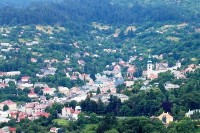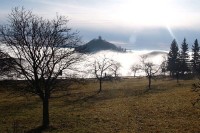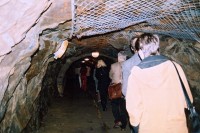Banská Štiavnica Historic Town and Surrounding Technical Monuments UNESCO World Heritage Site

 Situated in a large wooden basin caused by a collapsed volcano, Banská Štiavnica is a completely preserved medieval town with an important history of silver and gold mining. Bestowed the privileges of a royal town in 1238, it subsequently became a free royal town and between the 13th and 18th centuries the Banská Štiavnica ore field was among the richest in Europe. From 1735 to 1919 Banská Štiavnica was also the seat of the Mining Academy (Banskej akadémie), the first university of its kind in Europe and an institution of considerable cultural and historical significance. By 1783 Štiavnica was the third largest city in the Hungarian kingdom, next only to Bratislava and Debrecen. Because of their historical value, the old town and its technical monuments were inscribed on the UNESCO World Heritage list on 11 December 1993.
Situated in a large wooden basin caused by a collapsed volcano, Banská Štiavnica is a completely preserved medieval town with an important history of silver and gold mining. Bestowed the privileges of a royal town in 1238, it subsequently became a free royal town and between the 13th and 18th centuries the Banská Štiavnica ore field was among the richest in Europe. From 1735 to 1919 Banská Štiavnica was also the seat of the Mining Academy (Banskej akadémie), the first university of its kind in Europe and an institution of considerable cultural and historical significance. By 1783 Štiavnica was the third largest city in the Hungarian kingdom, next only to Bratislava and Debrecen. Because of their historical value, the old town and its technical monuments were inscribed on the UNESCO World Heritage list on 11 December 1993.
The town has two castles – the Old Castle (Starý zámok) constructed in the early 13th century on the site of the former Church of the Virgin Mary, and the New Castle (Nový zámok) which was built in the 16th century as an anti-Turkish fortification.
Starting in the 16th century, prosperous burghers poured their money into the construction of splendid houses. The historical Trinity Square (Námestie Svätej Trojice) was built during this period. Surrounded by beautiful Late Gothic and Renaissance houses, the square has at its centre an imposing Baroque plague column, designed by Italian sculptor Stanetti. In the square may be found the 16th-century Berggericht, once the seat of the Mining Court and later used by the famous Mining Academy, which now houses the Mineralogical Exposition, part of the Slovak Mining Museum. Another branch of this museum, the Jozef Kollár Gallery, is also located in the square. Just south of the square is the 15th-century Church of St Katarina, with its beautiful Late Gothic vaulting and interior woodcarvings and stonework.
 Other important historic buildings in Banská Štiavnica include the 16th-century Town Hall with its imposing Tower; the 17th-century Renaissance-Baroque 'Knocking Tower' (klopacka), which was used for calling miners to work; the 16th-century Kammerhof, which once served as the seat of the Mining Chamber and the Office of the Mining Chamber Counts but now houses the Slovak Mining Museum; and Scharffenberg (or Calvary) Hill, with its tree-lined trail leading past 14 Stations of the Cross up to an 18th-century triple-domed cathedral at the summit.
Other important historic buildings in Banská Štiavnica include the 16th-century Town Hall with its imposing Tower; the 17th-century Renaissance-Baroque 'Knocking Tower' (klopacka), which was used for calling miners to work; the 16th-century Kammerhof, which once served as the seat of the Mining Chamber and the Office of the Mining Chamber Counts but now houses the Slovak Mining Museum; and Scharffenberg (or Calvary) Hill, with its tree-lined trail leading past 14 Stations of the Cross up to an 18th-century triple-domed cathedral at the summit.
Located some two kilometres out of town, the Open Air Mining Museum offers a two kilometre-long underground excursion in mines which date back to the 17th century. Another ancient mine tunnel open to the public - the Glanzenberg Mining Tunnel - is even older. This tunnel, situated just under the centre of the town, has attracted numerous famous visitors, including Emperor Joseph II and Prince Albert of Monaco.
 The town is surrounded by ancient artificial mining water reservoirs called tajchy. Sixty reservoirs were built between the 15th and 18th centuries in order to provide energy for the booming mining industry. They are connected by a more than 100 kilometre-long network of channels. These extraordinary historical monuments are now used mainly for recreation.
The town is surrounded by ancient artificial mining water reservoirs called tajchy. Sixty reservoirs were built between the 15th and 18th centuries in order to provide energy for the booming mining industry. They are connected by a more than 100 kilometre-long network of channels. These extraordinary historical monuments are now used mainly for recreation.
Over the centuries the town of Banská Štiavnica has been visited by many outstanding engineers and scientists who have contributed to its fame. The old medieval mining centre grew into a town with Renaissance palaces, 16th-century churches, elegant squares and castles. The urban centre blends into the surrounding landscape, which contains vital relics of the mining and metallurgical activities of the past.
See UNESCO World Heritage Sites in Slovakia
